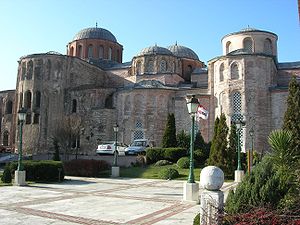Zeyrek Mosque
| Zeyrek Mosque Turkish: Molla Zeyrek Cami |
|
|---|---|

The mosque viewed from north east. From left to right, one can see the apses of the Church of Christ Pantocrator, the Imperial Chapel and the Church of the Theotokos Eleousa.
|
|
| Basic information | |
| Location | Istanbul, Turkey |
| Geographic coordinates | 41°1′11″N 28°57′26″E / 41.01972°N 28.95722°E |
| Affiliation | Sunni Islam |
| Year consecrated | Short after 1453 |
| Architectural description | |
| Architectural type | Church with cross-in-square plan |
| Architectural style | Middle Byzantine - Comnenian |
| Groundbreaking | Between 1118 and 1124 |
| Completed | Before 1136 |
| Materials | Brick |
Zeyrek Mosque (full name in Turkish: Molla Zeyrek Camii) or Monastery of the (in Turkish: Pantokrator Manastırı), is a significant mosque in Istanbul, made of two former Eastern Orthodox churches and a chapel. It represents the most typical example of architecture of the Byzantine middle period in Constantinople and is, after Hagia Sophia, the second largest religious edifice built by the Byzantines still standing in Istanbul.
The complex is placed in Fazilet Sokağı, in the district of Fatih, in a popular neighborhood which got its name (Zeyrek) from the Mosque, and less than one km to the southeast of Eski Imaret Mosque. It is picturesque but (as of 2007) decayed and dangerous in the night hours.
Between 1118 and 1124 Byzantine Empress Eirene Komnena built a monastery on this site dedicated to Christ Pantokrator ("Christ Almighty"). The monastery consisted of a main church (which became the katholikon, or main church, of the monastery ) also dedicated to Christ Pantocrator, a library and a hospital.
After the death of his wife, shortly after 1124, Emperor John II Komnenos built another church to the north of the first dedicated to the Theotokos Eleousa ("the merciful Mother of God"). This church was open to the population and served by a lay clergy. Finally (the terminus ante quem is 1136 ) a south courtyard and an exonarthex were added to the complex, and the two shrines were connected with a chapel dedicated to Saint Michael, which became the imperial mausoleum (heroon) of the Komnenos and Palaiologos dynasties. Besides many Byzantine dignitaries, Emperor John II and his wife Eirene, Empress Bertha of Sulzbach (also known as Eirene, and wife of Manuel I Komnenos), and Emperor John V Palaiologos were buried here.
...
Wikipedia
